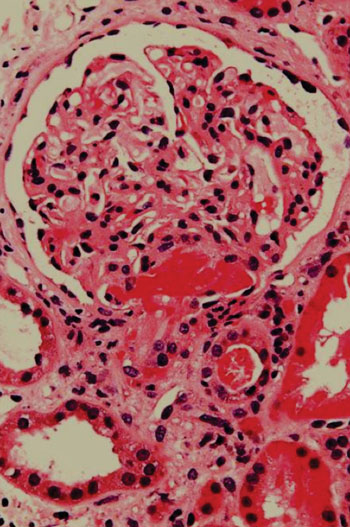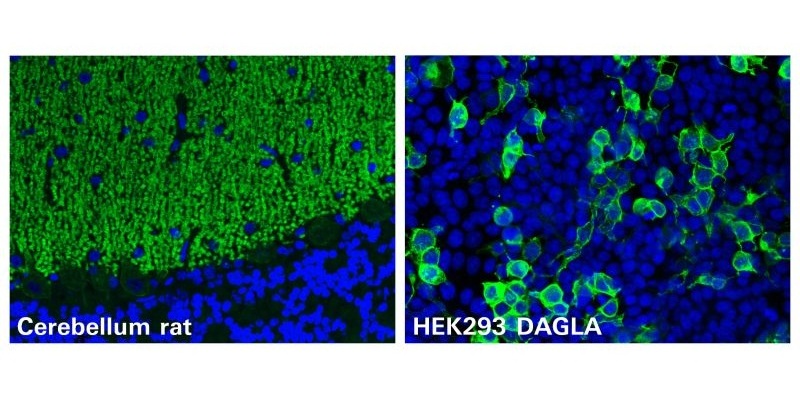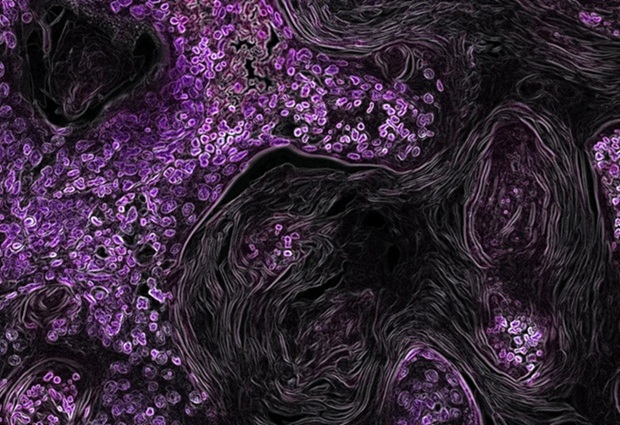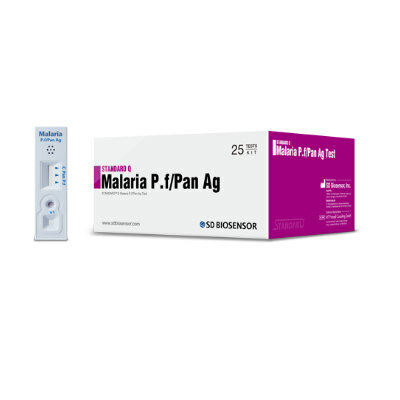Platelet Transfusions for Rare Blood Cell Disorders Increases Mortality Risk
|
By LabMedica International staff writers Posted on 28 Jan 2015 |

Image: Histology of a kidney biopsy from a patient with thrombotic thrombocytopenic purpura (TTP) showing an acute thrombotic microangiopathy (Photo courtesy of Nephron).
Patients hospitalized with certain rare blood cell disorders frequently receive a treatment that is associated with a two- to fivefold increase in death.
The risks and benefits associated with platelet transfusions have been studied in the rare blood disorders thrombotic thrombocytopenic purpura (TTP), heparin induced thrombocytopenia (HIT) and immune thrombocytopenic purpura (ITP).
Medical experts in transfusion medicine at the Johns Hopkins University School of Medicine (Baltimore, MD, USA) carried out a nationwide review of nearly 100,000 combined hospital admissions for three rare blood cell disorders: TTP, HIT and ITP. All three conditions are immune system disorders marked by low levels of platelets that help seal up damaged blood vessels. TTP is a life-threatening condition in which clots form in small blood vessels, resulting in a low overall platelet count. It occurs in less than one out of every 100,000 people per year. ITP is a less serious tendency to bleeding, seen in about one in every 20,000 children and one in every 50,000 adults, which often clears up on its own. HIT is a life-threatening reaction to the drug heparin, given to patients to prevent the formation of blood clots. For unknown reasons, in about 1% to 5% of patients given heparin, the immune system responds by producing clots rather than suppressing them.
Platelet transfusions were reported in 10.1% of all hospitalizations for TTP, 7.1% for HIT and 25.8% for ITP. In TTP, the odds of dying in the hospital doubled when the patient was given a platelet transfusion. In HIT, the odds of dying were five times greater with a platelet transfusion.
The scientists found that one in 10 TTP patients and one in 13 HIT patients got platelet transfusions, in spite of some practitioners' concerns about the risks. In some cases, the doctors may not have known the patient has a platelet disorder until they see the potentially deadly reaction to the transfusion.
Aaron A. R. Tobian, MD, PhD, an associate professor of pathology, said, “Because these conditions are so rare, they're difficult to study. There was some suggestion that transfusion may be harmful in these conditions, but it really was not known until now. Our study is the first one to show that platelet transfusions are frequently administered to patients with ITP, HIT and TTP, and that they're associated with higher odds of arterial blood clots and mortality in TTP and HIT.” The authors believe that for patients with HIT and TTP, platelet transfusions should be reserved only for severe, life-threatening bleeding refractory to other therapies or major surgery. For HIT patients, the first step is to stop administering heparin, and TTP patients should be transferred to a hospital that can administer plasma exchange therapy. The study was published on January 14, 2015, in the journal Blood.
Related Links:
Johns Hopkins University School of Medicine
The risks and benefits associated with platelet transfusions have been studied in the rare blood disorders thrombotic thrombocytopenic purpura (TTP), heparin induced thrombocytopenia (HIT) and immune thrombocytopenic purpura (ITP).
Medical experts in transfusion medicine at the Johns Hopkins University School of Medicine (Baltimore, MD, USA) carried out a nationwide review of nearly 100,000 combined hospital admissions for three rare blood cell disorders: TTP, HIT and ITP. All three conditions are immune system disorders marked by low levels of platelets that help seal up damaged blood vessels. TTP is a life-threatening condition in which clots form in small blood vessels, resulting in a low overall platelet count. It occurs in less than one out of every 100,000 people per year. ITP is a less serious tendency to bleeding, seen in about one in every 20,000 children and one in every 50,000 adults, which often clears up on its own. HIT is a life-threatening reaction to the drug heparin, given to patients to prevent the formation of blood clots. For unknown reasons, in about 1% to 5% of patients given heparin, the immune system responds by producing clots rather than suppressing them.
Platelet transfusions were reported in 10.1% of all hospitalizations for TTP, 7.1% for HIT and 25.8% for ITP. In TTP, the odds of dying in the hospital doubled when the patient was given a platelet transfusion. In HIT, the odds of dying were five times greater with a platelet transfusion.
The scientists found that one in 10 TTP patients and one in 13 HIT patients got platelet transfusions, in spite of some practitioners' concerns about the risks. In some cases, the doctors may not have known the patient has a platelet disorder until they see the potentially deadly reaction to the transfusion.
Aaron A. R. Tobian, MD, PhD, an associate professor of pathology, said, “Because these conditions are so rare, they're difficult to study. There was some suggestion that transfusion may be harmful in these conditions, but it really was not known until now. Our study is the first one to show that platelet transfusions are frequently administered to patients with ITP, HIT and TTP, and that they're associated with higher odds of arterial blood clots and mortality in TTP and HIT.” The authors believe that for patients with HIT and TTP, platelet transfusions should be reserved only for severe, life-threatening bleeding refractory to other therapies or major surgery. For HIT patients, the first step is to stop administering heparin, and TTP patients should be transferred to a hospital that can administer plasma exchange therapy. The study was published on January 14, 2015, in the journal Blood.
Related Links:
Johns Hopkins University School of Medicine
Latest Hematology News
- New Scoring System Predicts Risk of Developing Cancer from Common Blood Disorder
- Non-Invasive Prenatal Test for Fetal RhD Status Demonstrates 100% Accuracy
- WBC Count Could Predict Severity of COVID-19 Symptoms
- New Platelet Counting Technology to Help Labs Prevent Diagnosis Errors
- Streamlined Approach to Testing for Heparin-Induced Thrombocytopenia Improves Diagnostic Accuracy
- POC Hemostasis System Could Help Prevent Maternal Deaths
- New Test Assesses Oxygen Delivering Ability of Red Blood Cells by Measuring Their Shape
- Personalized CBC Testing Could Help Diagnose Early-Stage Diseases in Healthy Individuals
- Non-Invasive Test Solution Determines Fetal RhD Status from Maternal Plasma
- First-Of-Its-Kind Smartphone Technology Noninvasively Measures Blood Hemoglobin Levels at POC

- Next Gen CBC and Sepsis Diagnostic System Targets Faster, Earlier, Easier Results
- Newly Discovered Blood Group System to Help Identify and Treat Rare Patients
- Blood Platelet Score Detects Previously Unmeasured Risk of Heart Attack and Stroke
- Automated Benchtop System to Bring Blood Testing To Anyone, Anywhere
- New Hematology Analyzers Deliver Combined ESR and CBC/DIFF Results in 60 Seconds
- Next Generation Instrument Screens for Hemoglobin Disorders in Newborns
Channels
Clinical Chemistry
view channel
‘Brilliantly Luminous’ Nanoscale Chemical Tool to Improve Disease Detection
Thousands of commercially available glowing molecules known as fluorophores are commonly used in medical imaging, disease detection, biomarker tagging, and chemical analysis. They are also integral in... Read more
Low-Cost Portable Screening Test to Transform Kidney Disease Detection
Millions of individuals suffer from kidney disease, which often remains undiagnosed until it has reached a critical stage. This silent epidemic not only diminishes the quality of life for those affected... Read more
New Method Uses Pulsed Infrared Light to Find Cancer's 'Fingerprints' In Blood Plasma
Cancer diagnoses have traditionally relied on invasive or time-consuming procedures like tissue biopsies. Now, new research published in ACS Central Science introduces a method that utilizes pulsed infrared... Read moreMolecular Diagnostics
view channel
Blood Biomarker Test Could Detect Genetic Predisposition to Alzheimer’s
New medications for Alzheimer’s disease, the most common form of dementia, are now becoming available. These treatments, known as “amyloid antibodies,” work by promoting the removal of small deposits from... Read more
Novel Autoantibody Against DAGLA Discovered in Cerebellitis
Autoimmune cerebellar ataxias are strongly disabling disorders characterized by an impaired ability to coordinate muscle movement. Cerebellar autoantibodies serve as useful biomarkers to support rapid... Read more
Gene-Based Blood Test Accurately Predicts Tumor Recurrence of Advanced Skin Cancer
Melanoma, an aggressive form of skin cancer, becomes extremely difficult to treat once it spreads to other parts of the body. For patients with metastatic melanoma tumors that cannot be surgically removed... Read moreImmunology
view channel
Stem Cell Test Predicts Treatment Outcome for Patients with Platinum-Resistant Ovarian Cancer
Epithelial ovarian cancer frequently responds to chemotherapy initially, but eventually, the tumor develops resistance to the therapy, leading to regrowth. This resistance is partially due to the activation... Read more
Machine Learning-Enabled Blood Test Predicts Immunotherapy Response in Lymphoma Patients
Chimeric antigen receptor (CAR) T-cell therapy has emerged as one of the most promising recent developments in the treatment of blood cancers. However, over half of non-Hodgkin lymphoma (NHL) patients... Read moreMicrobiology
view channel
Handheld Device Delivers Low-Cost TB Results in Less Than One Hour
Tuberculosis (TB) remains the deadliest infectious disease globally, affecting an estimated 10 million people annually. In 2021, about 4.2 million TB cases went undiagnosed or unreported, mainly due to... Read more
New AI-Based Method Improves Diagnosis of Drug-Resistant Infections
Drug-resistant infections, particularly those caused by deadly bacteria like tuberculosis and staphylococcus, are rapidly emerging as a global health emergency. These infections are more difficult to treat,... Read more
Breakthrough Diagnostic Technology Identifies Bacterial Infections with Almost 100% Accuracy within Three Hours
Rapid and precise identification of pathogenic microbes in patient samples is essential for the effective treatment of acute infectious diseases, such as sepsis. The fluorescence in situ hybridization... Read morePathology
view channel
Novel UV and Machine Learning-Aided Method Detects Microbial Contamination in Cell Cultures
Cell therapy holds great potential in treating diseases such as cancers, inflammatory conditions, and chronic degenerative disorders by manipulating or replacing cells to restore function or combat disease.... Read more
New Error-Corrected Method to Help Detect Cancer from Blood Samples Alone
"Liquid biopsy" technology, which relies on blood tests for early cancer detection and monitoring cancer burden in patients, has the potential to transform cancer care. However, detecting the mutational... Read more
"Metal Detector" Algorithm Hunts Down Vulnerable Tumors
Scientists have developed an algorithm capable of functioning as a "metal detector" to identify vulnerable tumors, marking a significant advancement in personalized cancer treatment. This breakthrough... Read more
Novel Technique Uses ‘Sugar’ Signatures to Identify and Classify Pancreatic Cancer Cell Subtypes
Pancreatic cancer is often asymptomatic in its early stages, making it difficult to detect until it has progressed. Consequently, only 15% of pancreatic cancers are diagnosed early enough to allow for... Read moreTechnology
view channel
Disposable Microchip Technology Could Selectively Detect HIV in Whole Blood Samples
As of the end of 2023, approximately 40 million people globally were living with HIV, and around 630,000 individuals died from AIDS-related illnesses that same year. Despite a substantial decline in deaths... Read more
Pain-On-A-Chip Microfluidic Device Determines Types of Chronic Pain from Blood Samples
Chronic pain is a widespread condition that remains difficult to manage, and existing clinical methods for its treatment rely largely on self-reporting, which can be subjective and especially problematic... Read more
Innovative, Label-Free Ratiometric Fluorosensor Enables More Sensitive Viral RNA Detection
Viruses present a major global health risk, as demonstrated by recent pandemics, making early detection and identification essential for preventing new outbreaks. While traditional detection methods are... Read moreIndustry
view channel
Cepheid and Oxford Nanopore Technologies Partner on Advancing Automated Sequencing-Based Solutions
Cepheid (Sunnyvale, CA, USA), a leading molecular diagnostics company, and Oxford Nanopore Technologies (Oxford, UK), the company behind a new generation of sequencing-based molecular analysis technologies,... Read more
Grifols and Tecan’s IBL Collaborate on Advanced Biomarker Panels
Grifols (Barcelona, Spain), one of the world’s leading producers of plasma-derived medicines and innovative diagnostic solutions, is expanding its offer in clinical diagnostics through a strategic partnership... Read more


















